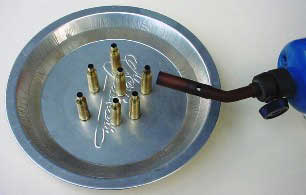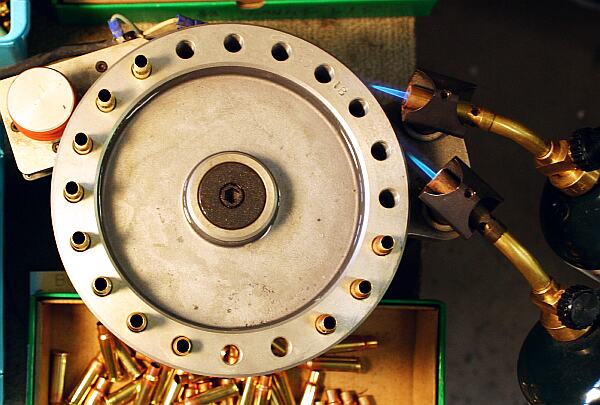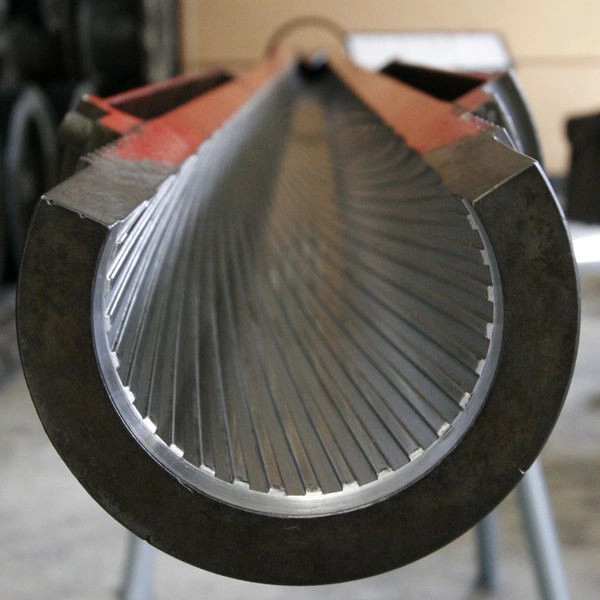In our previous article, we discussed why we would want to anneal our brass necks. This article, we will cover a couple of methods of ‘how’.
Like many things in reloading, everyone has an opinion on brass annealing methods and everyone is sure their opinion is right. Rather than adding to that here – I simply want to document several of the different methods I have read up about.
Liquid Lead (or Liquid) Bath
This method is one that you sometimes come across in a forum, but it’s hard to find much in the way of actual information. Which is probably a good thing, because dipping brass in molten metal is a fairly edgy proposition. Sure, if you know what you are doing there shouldn’t be any issues, but a combination of molten lead being a little temperamental1 and lead fumes means its really something better left alone.
The only photos I found was actually someone utilising a Salt Bath – the salts melt at the same temperatures lead does and provides a slightly safer alternative.
‘Hand Held’ and Driver Bit Method
This seems to be the way a lot of people get into brass annealing. In it’s simplest form, it is a case of holding a piece of brass and rotating it in front of a blow-torch. I have even read, that the point that you can’t hold the brass any-more is also, coincidently the perfect amount of heat to anneal brass. Please, if you believe that don’t ever set-up in the lane next to me on a range.
The evolution of this method seems to be to utilise an electric drill and bit (like the one used to remove/replace spark plugs). This means you don’t have to hold the hot brass and can provide a bit more consistency in the rotation in the flame. In fact, some companies (like Hornady) actually market specialists bits just for this job. You can even use the case holder from your press sets – but a socket allows you to dump the brass quicker.
This has also led to people developing rigs to hold the drill and the blowtorch, ranging from basic, to quite complex. A couple of bits of wood and you are good to go! There is an obvious connection between the kind of person who likes to reload and the kind of person who likes to build things in the workshop so there is no limit to the designs that you can come up with for brass annealing methods.
One such innovation is the use of dual flames in order to try and give a more even application of heat.
The water bath
Alternatively, some people will sit a pile of brass in a tray of water. The water bath ensures that you are only annealing the neck of the brass (go read the previous article to understand why that is important).

A lot of folk, regardless of method will use a water bath to quickly cool the brass down. It’s important to understand – this quick cooling has nothing to do with the annealing process. Steel can be tempered through quick cooling. Not brass. All that is required for brass to soften is heat2. The quick cooling certainly makes it easier to handle the brass quicker, but then you also need to dry the brass before any further steps. I guess, if you are also ultrasonically cleaning your brass you may already have a good drying system in place.
Machines (Simple)
Well, I say simple – but essentially meaning a funnel or chute the drops the brass down onto a platform that then rotates it in front of the torch.
Here we are heading towards more automation – once these machines are running, no further input (apart from checks) is required by the user – it means you can start the process and do something else while it is happening. Good use of time!
I like automation – or more correctly, I don’t like having to do repetitive tasks, so the machines obviously appeal to me.
There are even systems coming through that drop the torch and replace it with induction coils!
Machines (Complex)

And of course – there are the beasts that some guys decide to build (and sell).
Multiple torch heads, turntable style systems that promise high output and extreme consistency.
Of course, the sky is the limited when it comes to how much money you actually want to spend on your brass annealing methods and like many things, there is no doubt a law of diminishing returns. After having a play with a couple of systems, I ended up deciding on a unit that gives me a good balance of cost verses functionality and that will be the subject of the final article in this series.



